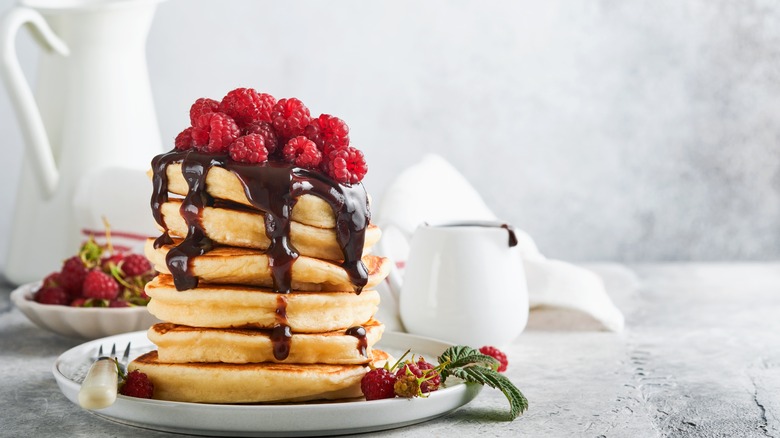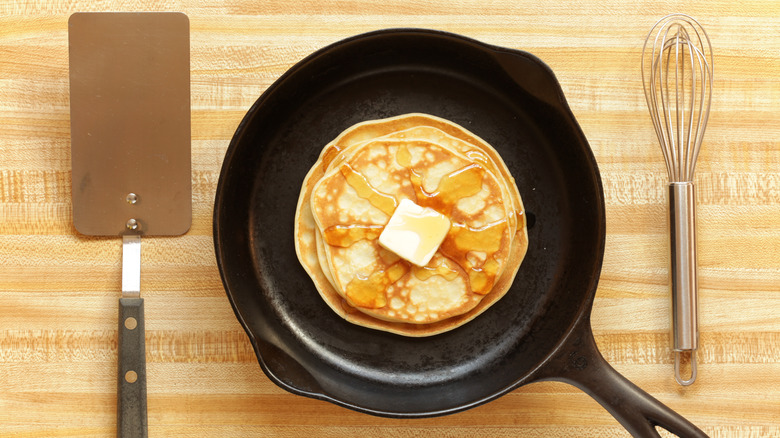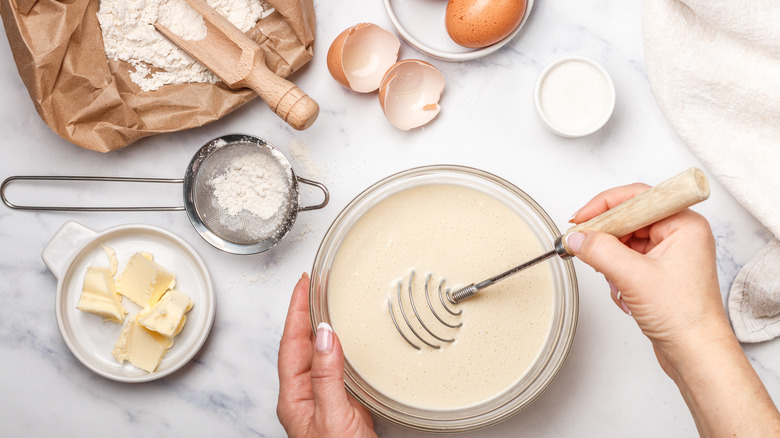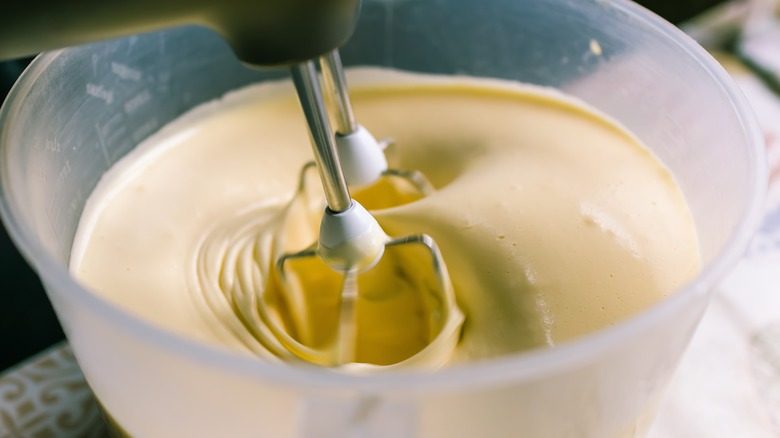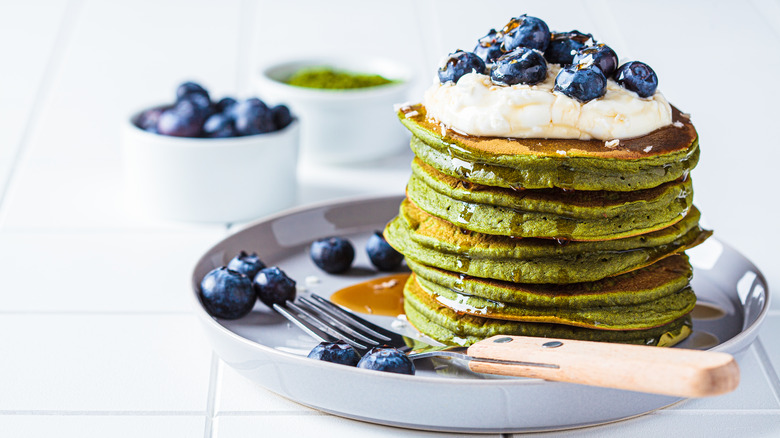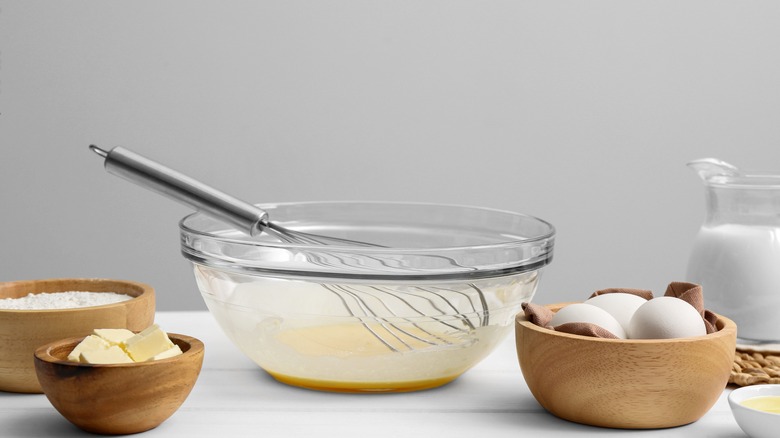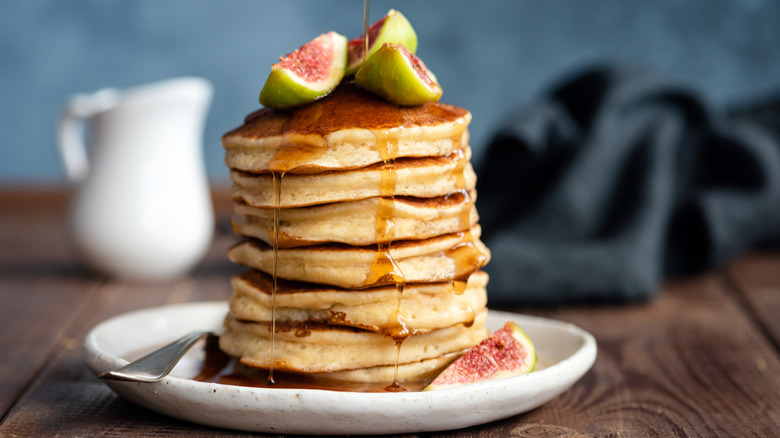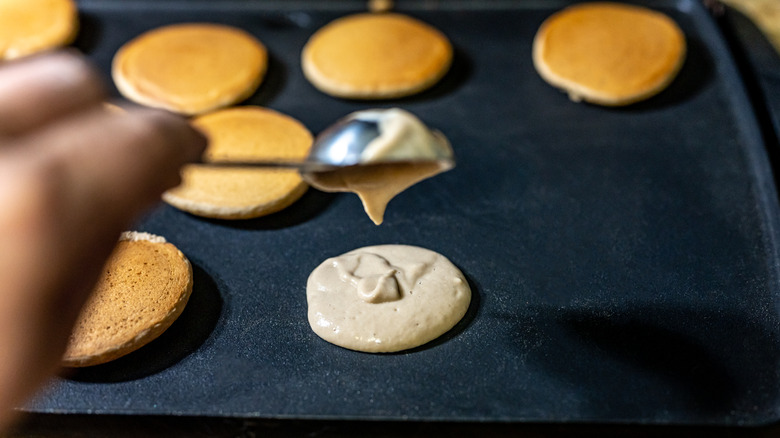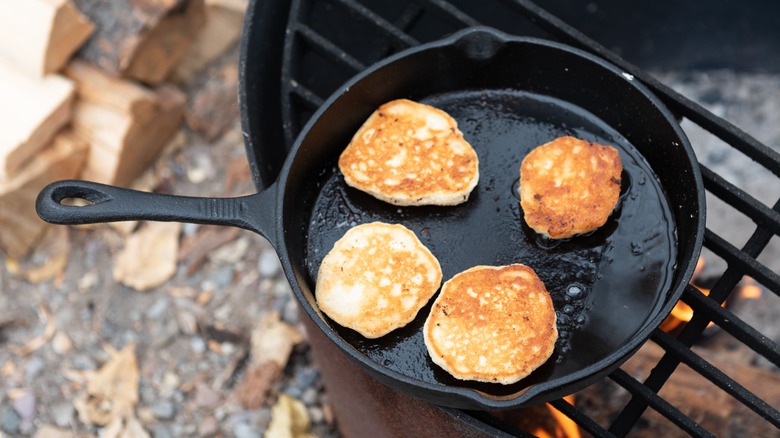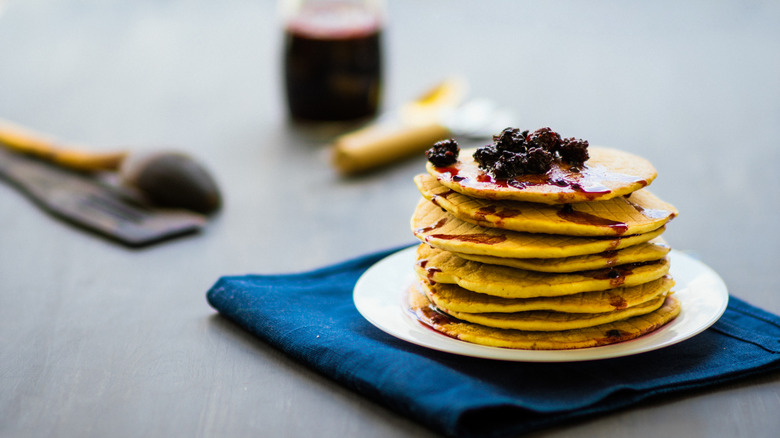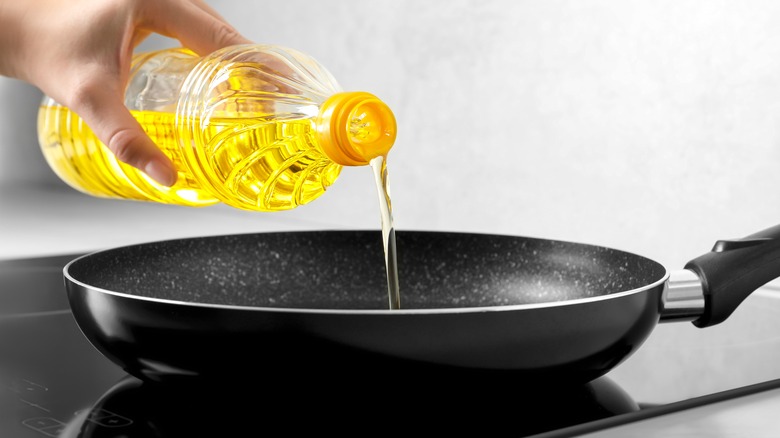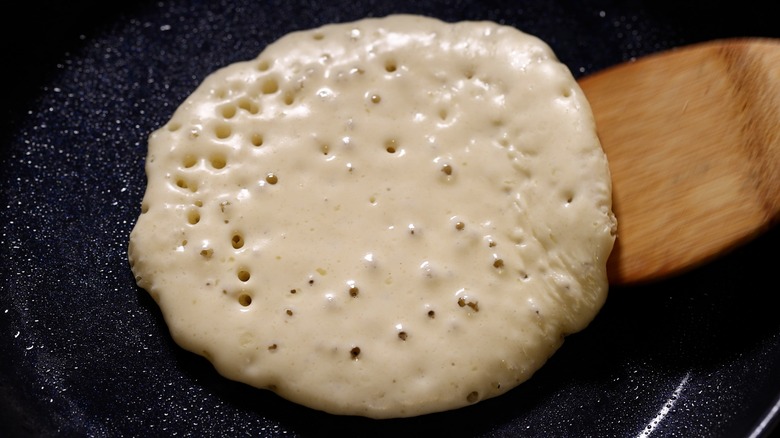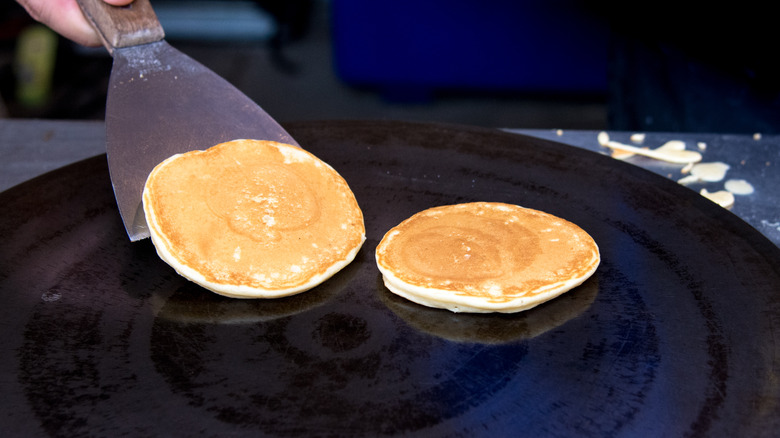Experts Help Us Debunk False Facts About Pancakes
Pancakes might be considered a favorite breakfast food in the U.S., but that doesn't necessarily mean they're easy to prepare. If that were the case, people would never complain of rubbery, lumpy, undercooked results that weren't worthy of the maple syrup they put on them. However, despite pancakes being in recipe books for more than a century, there's lot of misinformation out there about how to properly cook them.
Some of the most common mistakes people make when cooking pancakes are the result of simple misconceptions. For instance, many people believe that you should always aim for liquid smooth, lump-free batter, only to overmix and end up with tough pancakes in the pan. Others have long been told that the more bubbles in your batter, the better, but it turns out this isn't always the case.
All this to say, there are numerous misunderstandings surrounding this popular breakfast dish, and it's time to put them to bed. But, uncovering the truth means getting the experts involved. We spoke exclusively with two food bloggers and recipe developers who have extensive baking experience to debunk 12 false facts about pancakes you probably thought were true.
False: Pancakes are super simple to make
We're not saying that you need to have trained in a Michelin-starred kitchen to pull off decent pancakes. However, you should be aware that cooking them isn't as straightforward as say, making a bowl of cereal. If you're someone whose method has been to throw a bunch of flour, sugar, butter, and eggs in a bowl and hope for the best, chances are you've dealt with your share of poor pancakes.
But that doesn't mean you can't learn how to do it well. "Making perfect pancakes can seem challenging, but with the right techniques and a bit of practice, anyone can master it," says Becky Hardin, founder and recipe expert at The Cookie Rookie.
Aleka Shunk of food blog Aleka's Get-Together agrees. "Pancakes are hard to make from scratch and can be very temperamental," she tells Mashed. She also points out that what makes a perfect pancake for one person might not be the same for someone else. "For some, it's thick and fluffy, for others it's thin and sweet." But, according to Hardin, there are just a few factors to getting pancakes right. "The key lies in understanding the batter consistency, heat control, and timing," she says.
False: You can throw all the ingredients in at the same time
It's a common misconception that you can just throw all the ingredients in an old-fashioned pancake recipe together in a bowl at once, mix them up, and be good to go. This is known as an all-in-one recipe. Many baked goods are prepared this way, so it isn't a strange assumption to think that pancakes (which have the word 'cake' in them) would be the same.
But, Becky Hardin tells us this isn't the case. "Separating the dry and wet ingredients before mixing is crucial," she says. This is because it ensures the ingredients, such as leavening agents are well distributed through your flour. "Begin by whisking the liquid ingredients until bubbles form, then gently incorporate the dry ingredients [...] This method emulsifies the fat and water in the batter while minimizing over-mixing."
So while yes, this step creates dishes that you might prefer to avoid. But, it's totally worth it to get the best results. Sometimes the slower, more careful way is the route you need to take. We're all for saving time and effort, but we also want to make the best pancakes we can. So, we're taking this expert advice to heart.
False: You can't overmix pancakes
It's a common belief the ideal pancake batter is as smooth as possible. This has lead many people to believe that it's fine to crank up their electric mixer to achieve this consistency. However, overmixing can actually create textural problems in the finished dish. "It can lead to tough, rubbery pancakes," remarks Becky Hardin.
Aleka Shunk agrees that overmixing is a common pancake preparation mistake. Overworking occurs "because of the gluten in the flour," she explains. "As you mix it, it actually develops more gluten which leads to denser, chewier pancakes." For this reason, it's usually best to mix your batter by hand with a whisk, beater, or wooden spoon, rather than with an electric mixer. It's harder to overwork the mixture this way.
For the best consistency in the finished product, Hardin suggests combining wet and dry ingredients until they are just incorporated. There's no need to keep going once the ingredients have come together to form a batter. Hardin notes that people often overmix because they see lumps, but you actually don't need to fully get rid of them from the batter. Small ones are fine and will cook out of the pancakes. "Lumps often lead to fluffier pancakes," she says.
False: Pancakes can only be made with all purpose flour
Chances are, you've consulted an old-fashioned recipe book that stated to use all-purpose flour when preparing pancakes. Although this has a reputation as a tried-and-true pancake base, our experts both point out that it's far from your only option.
"Whole wheat, buckwheat, or almond flour can be used to make delicious pancakes with unique flavors and textures," Becky Hardin tells us. And, those flours are just the tip of the iceberg. Whether you want the added nutrition, or if you're gluten intolerant, there's a base you can use in place of all-purpose flour. Gluten-free flours, such as coconut flour and almond flour, taste especially great in pancakes due to their nuttiness and sweetness. However, keep in mind that the lack of gluten means they can fall apart more easily. If you aren't gluten free, using some all-purpose flour in the recipe to hold things together.
However, keep in mind that using different flours may require some extra steps, and in some cases, that you still incorporate some all-purpose flour. Using just whole wheat flour, for instance, can result in pancakes that are overly dense and bready. Instead, opt for a ratio of three parts all-purpose flour to one part whole wheat flour to yield fluffier, pliable results. Moreover when adapting an existing recipe that's written using just AP flour, you may need to add two to three tablespoons of additional liquid to get the same batter consistency.
False: There's no need to rest your batter
Wondering why pancakes tend to taste better at restaurants? Well, maybe you've been missing out a crucial step — resting the batter. Becky Hardin explains why — "It allows the flour to absorb the liquid and the gluten to relax, resulting in lighter, fluffier pancakes. And who doesn't like fluffy pancakes?" According to Hardin, you should ideally let the batter rest for 30 minutes before cooking. "But, even resting for 10 to 15 minutes can improve the texture," she adds.
We know that the last thing you want to do is wait even longer for your pancakes, but if you want the best results, it's well worth the extra step. Plus, if you'd rather not wait in the morning, there's a way around it: Make the batter in advance and rest it in the fridge overnight. By the time you wake up, it will be well-rested and you can get right to cooking.
False: Thick batter means thick pancakes
"Many believe that thicker batter leads to better pancakes, but this is not necessarily true," says Becky Hardin. In fact, when the batter is overly thick, you won't get the rise, height, and internal bubbles you want from great pancakes. This results in a thinner pancake with a texture that is at best, too dense, and at worst, undercooked and gluey.
So, what are you looking for instead? "The ideal batter consistency is pourable, similar to heavy cream," explains Hardin. She notes that this helps to "ensure even cooking," so they don't end up paste-like in the center with browned or burnt edges. Plus, the thinner consistency more easily lets bubbles form, which gives you that light, airy consistency.
Of course, pancake batter can also be too thin. This leads to flat pancakes without much structure to them. They'll be more like crepes than classic pancakes. And, while crepes are wonderful, that's not what you're trying to make here. Following a good recipe should give you batter of the right consistency. However, if it's too thick, add a little more milk until you get a pourable consistency. Or, if it's too thin and watery, start by letting it rest for 30 minutes. Still too thin? Add flour a tablespoon at a time until it thickens up correctly.
False: You need a griddle to cook pancakes
Sure, the best fast food pancakes are usually cooked on a griddle, but this isn't a must-have piece of equipment for making them. "The key is maintaining a consistent heat source and enough space to flip the pancakes easily," says Becky Hardin. "A good nonstick or cast iron skillet can also work well," she adds. Aleka Shunk backs this up to some degree, saying that you don't need a griddle to cook pancakes "but it definitely helps." She notes that "griddles often distribute heat better than a skillet and allow you to flip without touching the edge of the pan or another pancake." She says that another bonus is that "you can make more at once without letting the batter sit for too long."
So, the bottom line is that griddles aren't essential for making pancakes, but they do have their benefits. The large, flat surface makes pancakes easier to flip and gives you more space to cook them in general, which is great when making them for a crowd. However, there's no need to go out and buy one unless you want to. You can make do with whatever skillet you already have at home.
False: You always need a nonstick pan for pancakes
Sure, a nonstick pan has its advantages. Its slick surface practically guarantees a smooth pancake flip every time, without sticking or tearing. Plus, they are light and quick to heat up; ideal for those groggy mornings when you want a quick breakfast. However, if you don't own a nonstick pan, you're not out of luck for making pancakes, as there is another option: cast iron.
"Both cast iron and nonstick pans have advantages," Becky Hardin remarks. "Cast iron retains heat well and provides even browning" but "nonstick pans make flipping easier and require less oil." So, which is her favorite? "Personally, I prefer a nonstick griddle for its convenience and even cooking surface," she says.
But, Aleka Shunk has the opposite opinion. "Cast iron is better because it distributes the heat more evenly," she says. "This gives your pancakes that desired golden brown color without the burnt edges." Shunk adds that, with proper seasoning, cast iron pans have their own nonstick coating "so it's a win-win."
False: Maple syrup is the only topping option
For many people, it's hard to imagine a pancake topped with anything but maple syrup. This is in part due to habit, as people have been using it for generations. One pancake recipe published in the 19th century mentioned topping with maple syrup, and it seems to this day, people have followed that tradition. However, maple syrup is far from the only option out there. Corn and golden syrup are cheaper alternatives that can taste delicious sweet on a fresh-cooked hotcake. Agave nectar and honey, meanwhile, have a similar consistency to syrup. And, then, those who want to create a more dessert-like pancake experience can experiment with chocolate or butterscotch syrup.
Plus, there are plenty of non-syrup toppings you can put on pancakes, too. "Compotes, a combination of fresh fruit and sugar, are so easy to make in a saucepan," says Aleka Shunk. "Plus, they go very well with pancakes since they're a sweet, bright addition." Shunk also suggests making a compound butter as a complement. "This is a butter infused with something like orange zest, cinnamon, or even vanilla," she explains. "Some people don't want too much sugar on their pancakes, which makes this a great alternative."
Becky Hardin points out that keeping things simple is also an option. "You could simply dust them with powdered sugar and enjoy," she says. They also add that savory pancakes as an option, suggesting that people "experiment with ingredients like ham and cheese."
False: You need a hot pan to cook pancakes
If you believe you need to turn your stove up as high as it will go to get the best pancakes, you need to approach things with more nuance. Yes, you need to heat your pan up before adding the batter to get a good rise. However, this doesn't mean you need the burner turned right up. In fact, this can lead to issues.
"Cooking at too high a temperature can cause the outside to burn while leaving the inside undercooked," explains Hardin. "Low and slow cooking allows for even cooking and a golden-brown finish, which is just what we want." Hardin's advice is to cook at medium to medium-low heat until bubbles form on the uncooked side of the pancake and the edges are dry. This should take about 2 to 3 minutes. After this, flip your pancake and cook it until browned on the other side.
However, there is such a thing as too low of heat, according to Aleka Shunk. "If your pancakes are not rising within the first 20 to 30 seconds, your heat is too low and your pancakes will not be thick and fluffy which means you'll need to turn it up," she remarks.
False: The more bubbles on the surface, the fluffier the pancake
Have you heard that the more bubbles there are on the surface of a pancake, the fluffier it will be? Many people hold this belief because bubbles in pancakes are created by a chemical reaction that happens in the batter between a leavening agent, like baking powder, and an acidic component, like buttermilk. When these components combine, it creates a gas that causes the pancake to expand, resulting in a lifted, airy texture. So, if you're not seeing any bubbles at all, you might have forgotten to put it in the recipe, or your supply is past its best by date. In this case, you'll be left with dense, gummy pancakes.
However, while you should see some bubbles in your pancake, don't panic if your pancake isn't covered in them. There's a "misconception that the number of bubbles on the pancake's surface equals fluffy pancakes," Becky Hardin tells Mashed. But, it's not a clear indicator of a good pancake, in her opinion.
"In reality, achieving fluffy pancakes is more about the right balance of ingredients and minimal mixing, rather than the number of bubbles," she says. So, if you've been disappointed with the number of bubbles you've been able to achieve as you cook your batter, but pleased with the pancakes overall, there's no need to change anything.
False: Pressing down your pancakes helps them cook faster
Some people believe that pressing down on your pancakes with a spatula after flipping them will help them to cook faster. But, not only is there no evidence that this will speed up the process, it can also affect the texture of the finished dish.
When your pancakes are flat, it's likely the result of too much tampering in the pan. "If the goal is light and fluffy pancakes, which most people want, the last thing you want to do is squash them," says Aleka Shunk. "Flip them and let them be. Messing with them will only deflate them or cause misshapen pancakes."
Resist the urge to press down on your pancakes with your spatula, even if you think they will cook longer. They aren't burgers and this won't speed up cooking. All it will do is flatten out the air bubbles inside that you've worked hard to create. Instead, let each side cook on its own for approximately two to three minutes, until the sides are slightly dry and browned. That's your cue to flip. Let it cook for another minute before transferring to a plate for serving.
